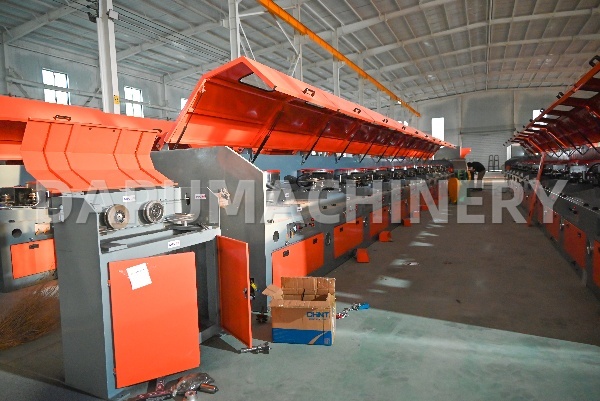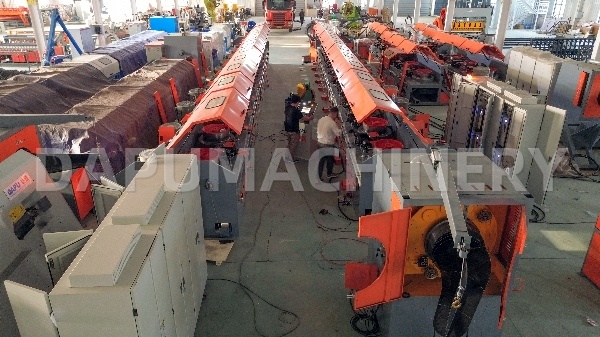
What Is a Straight Wire Drawing Machine and How Does It Work?
Category:News
Author:
Source:
Add time:2025-04-30 11:20
where infrastructure development and industrialization are rapidly growing—understanding the capabilities and advantages of modern wire drawing machines is vital. This article explores how straight wire drawing machines work, their applications, and why the DAPU Straight Wire Drawing Machine (Models LZ-560C and LZ-600C) addresses key challenges in these regions.


The wire drawing process involves pulling a metal wire through a series of progressively smaller dies to reduce its diameter. Here’s a simplified breakdown:
Loading the Raw Material: The wire (low, medium, or high carbon steel) is fed into the machine.
Lubrication & Cleaning: The wire is cleaned and lubricated to reduce friction during drawing.
Drawing Process: The wire passes through multiple dies, each reducing its diameter slightly.
Coiling: The finished wire is wound onto a reel for storage or transport.
Straight wire drawing machines are preferred for their efficiency in handling thicker wires and maintaining consistent quality. Unlike pulley-type machines, straight models use a linear arrangement of motor-driven rollers, ensuring smoother operation and higher precision.
Key Challenges in Emerging Markets
Users in South America, the Middle East, Southeast Asia, and Africa face unique challenges when selecting wire drawing machines. Here’s how the DAPU models provide targeted solutions:
1. Material Versatility for Diverse Applications
Pain Point: Markets like Africa and Southeast Asia rely on both low-cost low-carbon steel (for fencing, nails, and basic construction) and high-carbon steel (for automotive springs or reinforced cables). Machines that can’t handle multiple materials force buyers to invest in separate equipment.
DAPU Solution:
LZ-560C: Optimized for low-carbon wire (≤6.5mm inlet, ≥1.6mm outlet).
LZ-600C: Handles medium/high-carbon wire (≤8mm inlet, ≥4mm outlet).
This flexibility reduces costs for workshops serving varied industries.
2. Power Efficiency in Areas with Unstable Grids
Pain Point: Regions like rural South America or Africa often face electricity shortages. High-power machines strain local grids and raise operating costs.
DAPU Solution:
LZ-560C: 22KW motor balances performance and energy use.
LZ-600C: 30KW/37KW options adapt to higher workloads without excessive consumption.
Both models prioritize energy efficiency, cutting costs in power-scarce environments.
3. Durability for Harsh Conditions
Pain Point: Dust, humidity, and temperature extremes in the Middle East or Southeast Asia can shorten machine lifespans.
DAPU Solution:
Reinforced components resist corrosion and wear.
Large 560mm/600mm reels minimize frequent reloading, reducing operator exposure to harsh environments.
4. Speed vs. Precision Trade-Off
Pain Point: Fast production is crucial for meeting booming demand in construction sectors (e.g., Nigeria’s housing projects or Saudi Arabia’s infrastructure plans), but poor-quality wire leads to project delays.
DAPU Solution:
LZ-560C: Up to 16m/s outlet speed ensures rapid output.
Adjustable speed on the LZ-600C allows customization based on wire type and thickness.
Both models maintain precision even at high speeds, thanks to stable tension control.
5. Ease of Maintenance
Pain Point: Limited technical expertise in remote areas makes complex maintenance a barrier.
DAPU Solution:
Modular design simplifies part replacement.
Standardized die sizes reduce downtime for adjustments.
DAPU Machine Specifications at a Glance
| Parameter | LZ-560C | LZ-600C |
|---|---|---|
| Inlet Diameter | ≤6.5mm | ≤8mm |
| Outlet Diameter | ≥1.6mm | ≥4mm |
| Raw Material | Low-carbon wire | Medium/high-carbon wire |
| Reel Diameter | 560mm | 600mm |
| Outlet Speed | ≤16m/s | Adjustable* |
| Main Motor Power | 22KW | 30KW / 37KW |
*Speed varies based on inlet/outlet diameter ratios.
Why DAPU Machines Stand Out in Target Markets
Cost-Effective Scalability: Small workshops (common in Southeast Asia) can start with the LZ-560C and upgrade to the LZ-600C as demand grows.
Adaptability: Handles everything from soft aluminum wires (popular in African handicrafts) to rigid steel cables (used in Middle Eastern oil rigs).
Low Skill Barrier: Simple controls and minimal setup requirements suit regions with less technical training.
Conclusion
For businesses in emerging markets, choosing the right wire drawing machine directly impacts productivity and profitability. The DAPU LZ-560C and LZ-600C models address regional pain points—material diversity, power limitations, harsh environments, and maintenance challenges—through robust engineering and adaptable designs. By investing in these machines, manufacturers can produce high-quality wires efficiently, supporting local industries and fueling economic growth.
Whether you’re producing barbed wire for Kenyan farms, steel cables for Dubai’s skyscrapers, or copper wires for Vietnamese electronics, DAPU’s straight wire drawing machines offer a reliable, future-proof solution.
Recommend News




